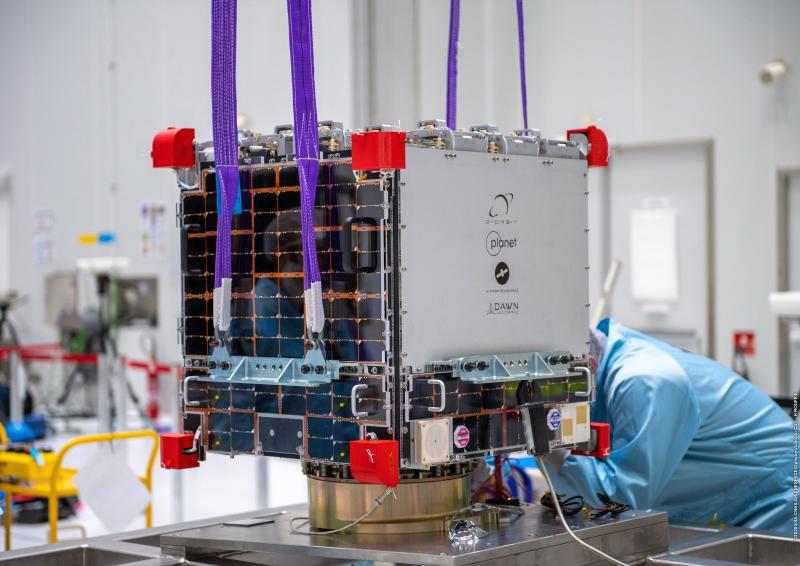A company based on the shores of Lake Como builds satellite carriers to gather climate change data from space and to clean up decades of debris
Satellites that capture images of climate change help people and first responders when terrestrial networks are damaged by natural disasters, like hurricanes or earthquakes. They digitally connect isolated patients or those living in rural areas to health care professionals in case of a pandemic. And they provide data for tracking the dangers of global warming —and our progress in fighting it.
But satellites also generate space junk. When they have completed their missions, small satellites are brought back to the earth to burn in the atmosphere. Bigger ones are redirected to spacecraft cemeteries in the oceans or are kept floating in controlled graveyard orbits, if there is a chance they could come to earth in a dangerous place. There are now about 2 000 operational satellites orbiting the Earth, so it’s time to figure out how to deal with increasing space debris.
D-Orbit, a New Space company headquartered near Lake Como in Italy, is pioneering sustainable space economy and space logistics.
“Several of our customers are earth observation operators, delivering data and information about weather, pollution, forestry and agriculture, oceans, coastal erosion and critical infrastructure,” says Luca Rossettini, chief executive and founder of D-Orbit. “Space is an opportunity for our society, for our industries and research institutions.”
In October 2020, D-Orbit launched—with the European Vega rocket from the Guiana Space Centre—its first ION (In Orbit Now) satellite carrier, which successfully deployed 12 Planet SuperDove Earth-imaging small satellites on a 500 kilometre sun-synchronous orbit. These SuperDove satellites complement the existing fleet of Planet’s satellite constellation to increase the coverage and capacity.
The ION satellite carrier developed by D-Orbit is backed by the European Investment Bank with a €15 million loan. The financing falls under a Memorandum of Understanding signed between the European Investment Bank and the European Space Agency in 2018.
D-Orbit is among the first deals completed by the EIB in the New Space sector. The financing falls under a 2018 memorandum of understanding between the Bank and the European Space Agency. “We hope this operation will be the first of many in light of the great momentum of the space sector, which is finally accessible to many market players,” says Hristo Stoykov, head of growth finance and venture debt at the EIB.
Adds Fabrizio Morgera, the EIB senior loan officer who worked on the deal, “We believe that the whole space value chain needs to be financed and supported to meet the great challenges of the near future.”

ION satellite carrier
Micro and nano satellites
D-Orbit’s cargo satellite missions are operated from its headquarters at Lake Como. They are designed to be launched by many different rockets available in the market. It is a sort of space taxi capable of hosting several nano or micro satellites.
These miniaturised CubeSats weigh a few kilogrammes each. There is also the possibility of carrying other types of payload, such as technologies developed by start-ups, research institutions and space companies that need to test and validate a technology in space before being able to commercialise it.
“The ION satellite carrier is an innovative solution to support small sat operators in testing their technologies in space (In-Orbit Validation) and to accelerate the commercialisation of new satellite services.” says Christian Kohr, the EIB Digital Infrastructure lead engineer, who worked on the D-Orbit loan. Adds Anders Bohlin, the EIB lead economist on the project: “With the ION concept, D-Orbit is an innovation leader in this field.”
Once fully operational, the space taxi will bring each payload faster to its final destination in orbit than it is possible today. ION is modular, with each module designed and produced as a sort of Lego brick, so that it can be fully reconfigured depending on the needs of the payloads.
Space debris cleanup
D-Orbit’s first two space missions laid the groundwork for Origin. The first, in 2013, proved the Lego bricks system works. The second, in 2017, tested the “satellite as a service” business model and validated the decommissioning system.
The company has developed a system called D3 (D-Orbit Decommissioning Device), supported by the European Commission and by the European Space Agency, to safely dispose of satellites at the end of their lives, so as not to contribute to the problems caused by approximately 130 million pieces of space debris. D-Orbit reckons a space circular economy is possible and that recycling in space will soon become a new business. That will include building spaceships in space by using local resources such as dead satellites.
(D-Orbit is a successful alumnus of the European Space Agency incubator in Lisbon and partnered with the Agency in 2019 on Project Sunrise, aimed at active debris removal.)
On the same mission, D-Orbit collaborated with the National Inter-University Consortium for Telecommunications and the University of Florence Research Unit to host the in-orbit validation of SatAlert, a satellite-based communication protocol. SatAlert provides geo-localised information on food and shelter in case of natural disasters, even in the absence of local connectivity.
Climate data open to all
Earth observation plays an important role for the European Space Agency, whose Sentinel missions have been part of the European Union’s Copernicus programme.
The Space Agency’s Climate Office is also planning to increase the exploitation of datasets provided by satellite observation to meet the targets defined by the Paris Agreement to fight the consequences of climate change. Data provided by the Sentinel missions are free and open to all users.
The hole in the ozone layer was discovered using Earth observation in the mid-1980s. The Montreal Protocol was signed in 1987 and 40 years later, the ozone layer is showing the first signs of recovery. “This is a momentous occasion for space in Europe, because it represents the graduation of New Space as a bankable and sustainable business. And more is to come: over 2 000 companies have joined the European Space Agency ecosystem,” says Elia Montanari, head of Management and Control in the European Space Agency’s Business Applications area.
